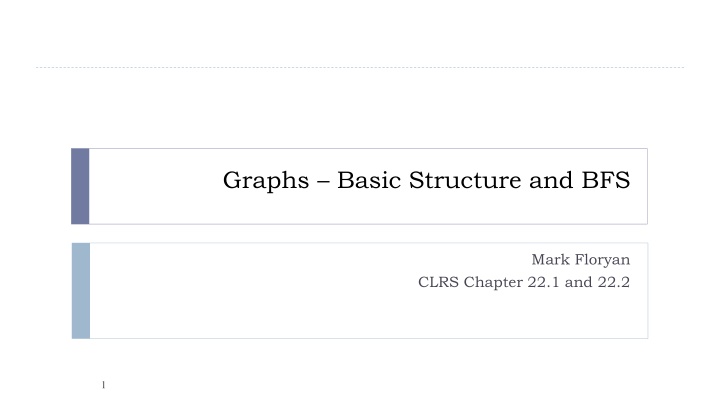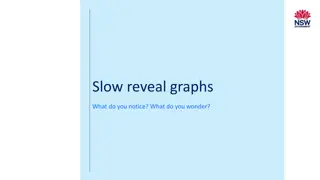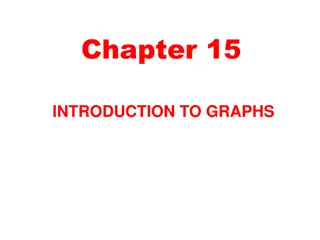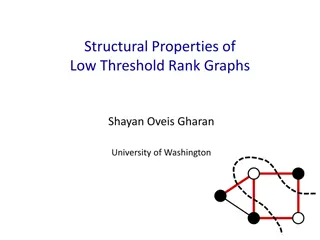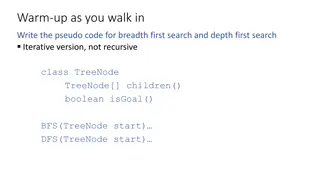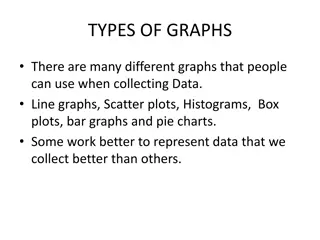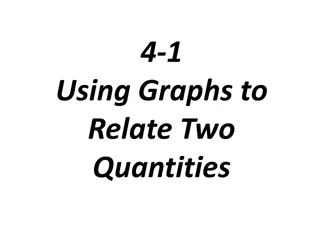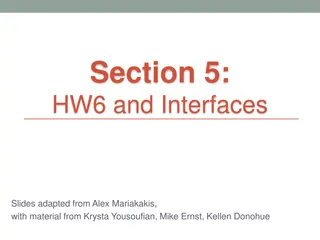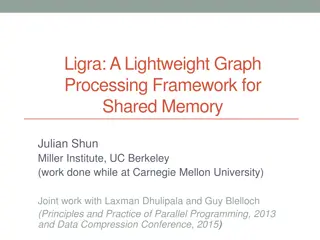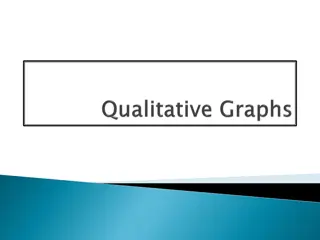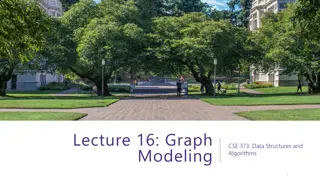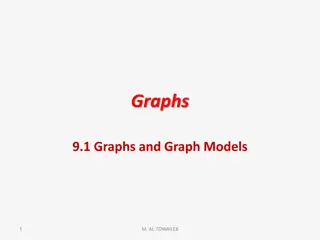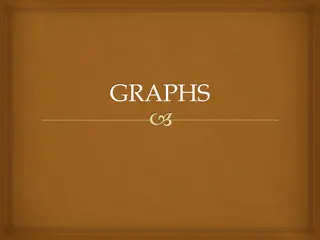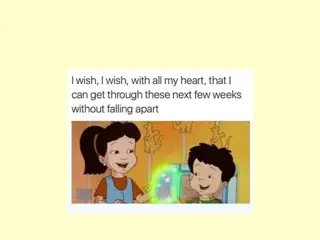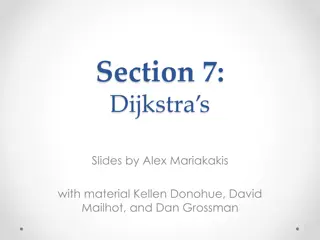Graphs: Basic Structure and BFS Overview
Explore the fundamental concepts of graphs, including representation methods, traversal algorithms like Breadth First Search (BFS), and key terminology such as vertices, edges, and degrees. Understand the distinction between directed and undirected graphs, along with real-world applications and problem scenarios like airline routes and computer networks.
Download Presentation

Please find below an Image/Link to download the presentation.
The content on the website is provided AS IS for your information and personal use only. It may not be sold, licensed, or shared on other websites without obtaining consent from the author.If you encounter any issues during the download, it is possible that the publisher has removed the file from their server.
You are allowed to download the files provided on this website for personal or commercial use, subject to the condition that they are used lawfully. All files are the property of their respective owners.
The content on the website is provided AS IS for your information and personal use only. It may not be sold, licensed, or shared on other websites without obtaining consent from the author.
E N D
Presentation Transcript
Graphs Basic Structure and BFS Mark Floryan CLRS Chapter 22.1 and 22.2 1
Module 1 Topics (Bolded items in this deck) Graph Representation What is a graph? Adjacency Lists vs. Matrices Traversing Graphs: Breadth First Search Traversing Graphs: Depth First Search Topological Sort Strongly Connected Components 3
Graphs 4
Problems: e.g. Binary relation x is a proper factor of y 5
Definition: Directed graph Directed Graph A directed graph, or digraph, is a pair G = (V, E) where V is a set whose elements are called vertices, and E is a set of ordered pairs of elements of V. Vertices are often also called nodes. Elements of E are called edges, or directed edges, or arcs. For directed edge (v, w) in E, v is its tail and w its head; (v, w) is represented in the diagrams as the arrow, v -> w. In text we simple write vw. 6
Definition: Undirected graph Undirected Graph A undirected graph is a pair G = (V, E) where V is a set whose elements are called vertices, and E is a set of unordered pairs of distinct elements of V. Vertices are often also called nodes. Elements of E are called edges, or undirected edges. Each edge may be considered as a subset of V containing two elements, {v, w} denotes an undirected edge In diagrams this edge is the line v---w. In text we simple write vw, or wv vw is said to be incident upon the vertices v and w 7
There are a lot of Graphs Terms Vertex (plural vertices) or Node Edge (sometimes referred to as an arc) Note the meaning of incident Degree of a vertex: how many adjacent vertices Digraph: in-degree (num. of incoming edges) vs. out-degree Graphs can be: Directed or undirected Weighted or not weighted weights can be reals, integers, etc. weight also known as: cost, length, distance, capacity, Undirected graphs: Normally an edge can t connect a vertex to itself A directed graph (also known as a digraph) Originating node is the head, the target the tail An edge may connect a vertex to itself 11
More Graph Terms Size of graph? Two measures: Number of nodes. Usually V Number of edges: usually E Dense graph: many edges Maximally dense? Undirected: each node connects to all others, so e = v(v-1)/2 Called a complete graph Directed: e = v(v-1) why? Sparse graph: fewer edges Could be zero edges 12
Terms You Should Know or Learn Now Path vs. simple path One vertex is reachable from another vertex A connected graph undirected graph, where each vertex is reachable from all others A strongly connected digraph: direction affects this! node u may be reachable from v, but not v from u Strongly connected means both directions Connected components for undirected graphs 13
Terms You Should Know or Learn Now Cycle Directed graph: non-empty path with same starting and ending node An edge may appear more than once (but why?) Simple cycle: no node repeated except start and end Undirected graph: same idea If an edge appears more than once (I.e. non-simple) then we traverse it in the same direction Acyclic: no-cycles A connected, acyclic undirected graph: free tree If we specificy a root, it s a rooted tree Acyclic but not connected? a undirected forest Directed acyclic graph: a DAG 14
Self-test: Understand these Terms? Subgraph Symmetric digraph complete graph Adjacency relation Path, simple path, reachable Connected, Strongly Connected Cycle, simple cycle acyclic undirected forest free tree, undirected tree rooted tree Connected component 15
Definitions: Weighted Graph A weighted graph is a triple (V, E, W) where (V, E) is a graph (directed or undirected) and W is a function from E into R, the reals (integer or rationals). For an edge e, W(e) is called the weight of e. 16
Graph Representations using Data Structures Adjacency Matrix Representation Let G = (V,E), n = |V|, m = |E|, V = {v1, v2, , vn) G can be represented by an n n matrix 17
Array of Adjacency Lists Representation from -> to, weight 20
Traversing Graphs Traversing means processing each vertex edge in some organized fashion by following edges between vertices We speak of visiting a vertex. Might do something while there. Recall traversal of binary trees: Several strategies: In-order, pre-order, post-order Traversal strategy implies an order of visits We used recursion to describe and implement these Graphs can be used to model interesting, complex relationships Often traversal used just to process the set of vertices or edges Sometimes traversal can identify interesting properties of the graph Sometimes traversal (perhaps modified, enhanced) can answer interesting questions about the problem-instance that the graph models 22
BFS: Whats the point Two purposes: 1) Traverse the graph! Visit every node and do something. 2) Learn something about the distance each node is from the starting node distance here means number of edges away 23
BFS: Overall Strategy Breadth-first search: Strategy choose a starting vertex, distance d = 0 vertices are visited in order of increasing distance from the starting vertex, examine all edges leading from vertices (at distance d) to adjacent vertices (at distance d+1) then, examine all edges leading from vertices at distance d+1 to distance d+2, and so on, until no new vertex is discovered 24
BFS: Specific Input/Output Input: A graph G single start vertex s Output: Shortest distance from s to each node in G (distance = number of edges) Breadth-First Tree of G with root s Note: The paths in this BFS tree represent the shortest paths from s to each node in G 25
Breadth-first search, quick example Let s start at V0 26
Breadth-first search implementation Vertices here have some properties: color = white/gray/black d = distance from start node pi = node through which d is achieved 27
Breadth-first search: Analysis For a digraph having V vertices and E edges Each edge is processed once in the while loop for a cost of (E) Each vertex is put into the queue once and removed from the queue and processed once, for a cost (V) Total: (V+E) Extra space is used for color array and queue, there are (V) From a tree (breadth-first spanning tree) the path in the tree from start vertex to any vertex contains the minimum possible number of edges Not all vertices are necessarily reachable from a selected starting vertex 28
Correctness of BFS First, some observations! 29
Breadth-first search: Some Properties Does BFS always compute (s,v) correctly, where (s,v) is the shortest path (number of edges) from s to any vertex v? Lemma 1: Let G=(V,E) be a directed or undirected graph, and let ? ? V be an arbitrary vertex. Then, for any edge ?,? ? ? (s,v) (s,u) + 1 30
Breadth-first search: Some Properties Lemma 2: Let G = (V,E) be a directed or undirected graph, and suppose BFS is run on G from a given source vertex ? ?, Then upon termination, for each vertex ? ?, the value v.d computed by BFS satisfies ?.? ?(?,?) ^^^^This is a weak bound! Just says distance will not be better than best path. //By how code updates v.d //By inductive hypothesis //By Lemma 1 on previous slide 31
Breadth-first search: Some Properties Lemma 3: Suppose during BFS execution, the Queue contains vertices {v1,v2, .vn} where v1 is at head of queue and vn is at tail of queue. Then: ??.? ?1.? + 1 ??.? ??+1.? //all nodes on Q differ by at most 1 //nodes on Q are non-decreasing distances for i = 1,2,3, .,n-1 Why? 32
Proof of Correctness Claim: Let G=(V,E) be a directed or undirected graph, and suppose that BFS is run on G from a given source vertex ? ?. Then, during its execution, BFS discovers every vertex ? ? that is reachable from s, and upon termination ?.? = ?(?,?) for all ? ?. 34
REMINDER: The Code! Vertices here have some properties: color = white/gray/black d = distance from start node pi = node through which d is achieved 35
Proof of Correctness Proof by Contradiction: Assume that BFS does NOT work. Then there MUST exist at least one node v such that ?.? ?(?,?) There might be more, but let v be such a node with the smallest ?(?,?) value Meaning the closest one to s that BFS incorrectly calculates. This is a good choice because we can assume all nodes with smaller d value were computed correctly! Nice! 36
Proof of Correctness So, this incorrectly calculated node v has the following property: ?.? > ? ?,? = ? ?,? + 1 = ?.? + 1 By how we chose v By definition of optimal path Because of Lemma 2! 37
Proof of Correctness ?.? > ? ?,? = ? ?,? + 1 = ?.? + 1 So at some point during execution. The node u is popped off the queue and the edge e=(u,v) is followed and node v is processed. Three cases: Case 1: v is white Case 2: v is gray Case 3: v is black 38
Proof of Correctness ?.? > ? ?,? = ? ?,? + 1 = ?.? + 1 Case 1: v is white If v is white, algorithm sets ?.? = ?.? + 1 (line 15). Contradiction! above formula shows ?.? > ?.? + 1 39
Proof of Correctness ?.? > ? ?,? = ? ?,? + 1 = ?.? + 1 Case 2: v is gray if v is gray, then v is currently on the queue. v was turned gray by dequeuing some other node w, setting ?.? = ?.? + 1 Order on queue: w, then u, then v, Lemma 3 gives ?.? ?.? ?.? So: ?.? = ?.? + 1 ?.? + 1 ^^Contradiction! 40
Proof of Correctness ?.? > ? ?,? = ? ?,? + 1 = ?.? + 1 Case 3: v is black if v is black, then v was previously on queue ahead of u queue distance values monotonically increasing, so ?.? ?.? (Lemma 3) Thus ?.? ?.? < ?.? + 1 ^^Contradiction!! 41
Proof of Correctness Finishing out the proof! If BFS is wrong then either: ?.? < ? ?,? No! By Lemma 2 ?.? > ?(?,?) No! By proof by contradiction / 3 cases Thus, ?.? = ?(?,?) 42
